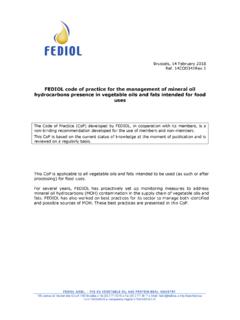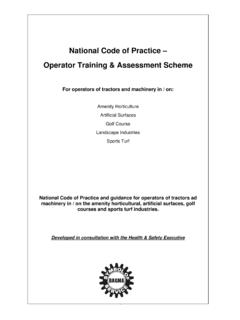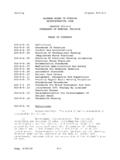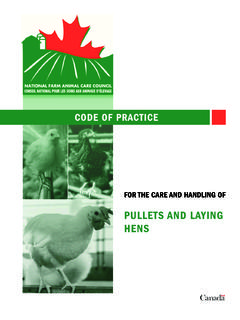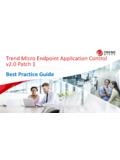Transcription of Competition in Connections Code of Practice
1 The Voice of the Networks Version 26 April 2017 Competition in Connections code of Practice The Voice of the Networks 2 Competition in Connections code of Practice Produced in accordance with standard condition 52 of the Electricity Distribution Licence Version Control Version : Including approved modification proposals 0001 and 0002 30 April 2016. Version : Including approved modification proposal 0003 13 July 2016. Version : Including approved modification proposal 0004 18 January 2017. Verson : Including approved modification proposal 0005 26 April 2017. The Voice of the Networks 3 Preface The market for the provision of electricity Connections to a DNO s Distribution System has evolved over the last 15 years, from a time where such Connections could only be provided by the DNO, to a market where providers other than the DNO can undertake many of the connection Works in Competition with the DNO.
2 As part of the Distribution Price Control Review for the period 2010-15 (DPCR5) Ofgem implemented measures to facilitate Competition in the provision of Connections . One of these was the creation of a Competition test assessment process for nine Relevant Market Segments (RMSs) whereby DNOs could apply to have price regulation lifted if they were able to demonstrate that Competition was sufficiently effective to protect the interests of Customers. At the end of the process Ofgem concluded that, across the 14 DNO Distribution Services Areas, effective Competition existed in only 42 of the 126 RMSs and that: It was more prevalent in the Distribution Services Areas of some DNOs than it was in others; and Some RMSs may have better conditions for Competition than others.
3 As a consequence of continued concerns about whether Competition in the Connections market was effective, Ofgem commenced a review of that market in 2014. In January 2015 Ofgem published its findings document1 where, in its executive summary, it stated: Our review has found problems that combine to limit the development of Competition . Together, these can make it hard to compete against the DNO on price and the timeliness of connection . These issues also increase the perceived risk and hassle of using an alternative connection provider for customers. Effective Competition should lead to lower prices, better service and more innovation. If Competition is not being allowed to develop then customers are losing out. Many of the issues restricting Competition relate to the DNO s role in the connection process.
4 In each region, the DNO is the sole provider of a number of the key inputs needed to make a connection . It provides these to both its own Connections business and to its competitors. Over the last decade, the DNOs have gradually changed their processes and procedures to minimise the impact of their position in the competitive process. Electricity North West Limited and Western Power Distribution have been particularly praised by stakeholders for their recent efforts to improve. However, no DNO has independently put in place enduring arrangements to deal with all the issues. Also, across GB, we have found inconsistencies between DNOs in how they manage the competitive connection process creating further complexity for competitors.
5 In setting out its proposed remedy Ofgem summarised: ..we think there is sufficient evidence to show that there are behavioural changes that can be made by the DNOs that could resolve the issues identified without the need for fundamental structural reform." Ofgem went on to say: We are acting to ensure that there is an enduring focus by all DNOs on adopting, harmonising and maintaining best Practice behaviour across all of this market. We intend to do this by introducing a new licence condition to require DNOs to reduce the extent to which competitors depend on them for essential services. Where the DNO is required to provide these services, it will need to do so on the same basis to both 1 The findings of our review of the electricity Connections market , Ofgem, 21 January 2015 The Voice of the Networks 4 its competitors and its own Connections business.
6 DNOs will collectively need to harmonise their arrangements for Competition . This will be achieved by an enforceable code of Practice (CoP) with which DNOs will have to comply." The main body of Ofgem's consultation went on to set out its views on the requirements for such code of Practice and on the structure and content of the licence condition that would underpin it. On 16 February 2015 the ENA, acting for and on behalf of DNOs, wrote to Ofgem confirming DNOs intent to work together with the aim of producing a common code of Practice . DNOs are committed to putting arrangements in place that facilitate effective and efficient Competition in the market for the provision of Connections . Such arrangements will help improve the quality of service that Customers receive and reduce the cost of connection .
7 Competition can also encourage innovation in the type of services on offer. A well-functioning market for Connections to the distribution network should benefit us all Connections that are timely and cost-effective help the economy to grow and help to decarbonise the energy we use. This code of Practice sets out the processes and practices that DNOs will follow to facilitate Competition in the provision of Connections to DNOs Distribution Systems by third-party connection providers. The code of Practice is expected to evolve in line with and in response to changes in the Connections market. The Voice of the Networks 5 Contents Part A Introduction Introduction 5 Scope and Objectives 6 Definitions 7 Part B The Connections Process The connection Application 11 Determining the Point of connection 12 Determining whether ICPs can undertake assessment of the POC 13 DNO input Services where the ICP determines the POC 14 DNO input Services where the DNO determines the POC 15 Point of connection Accreditation 15 POC assessment Using Standard Design Matrix 15 POC assessment Using the technical competence of the ICP 17 Information Exchange 17 _____Self Determination Information 18 Use of Link Boxes for LV Connections 19 Boundary Metering 20 Design Approval 20 Construction Works 22 Final connection 23 Part C Accreditation and
8 Authorisation of ICPs/DNOs Accreditations 24 Authorisations 24 Part D Auditing and Inspection Auditing 26 Inspection 26 Part E The Legal Process The Legal Process 27 Land Rights 27 Planning and Environmental Consents 27 Adoption 27 Part F Governance Arrangements Governance Arrangements 28 Part G Reporting Requirements Reporting Requirements 29 Part H Dispute Resoluation Dispute Resolution 29 Appendix 1 Governance Arrangements Scope 30 _____Definitions and Interpretation 30 Function and construction of Panel 31 Panel Members 34 Operation of the Panel 37 Costs of the code Administrator and Panel Secretary 43 The Voice of the Networks 6 Part A 1. Introduction The goal of this document is to codify the established and developing arrangements between DNOs and ICPs for facilitating the effective operation of Competition in the market for the provision of Connections .
9 In doing so it addresses the issues Ofgem has identified in its review of the Connections market. It also seeks to foster the same high standards of performance by all relevant parties in all aspects of their involvement in the competitive Connections market and promote the harmonisation of processes across DNOs to help foster Competition . In seeking Connections to a DNO s Distribution System, Customers can choose to use an ICP to undertake certain elements of the connection Works that would otherwise be undertaken by the DNO. Such elements of work are described as Contestable Works. Contestable Works can be carried out by: i) The DNO; or ii) an Independent Connections Provider (ICP) who may undertake Contestable Works on the basis that (following successful completion of the Contestable Works): the Contestable Works are adopted by the DNO to form part of its Distribution System; or some or all of the Contestable Works are operated by an IDNO or by a licence exempt electricity distributor as a separate distribution network which connects to the DNO's Distribution System.
10 This code of Practice is provided and maintained pursuant to standard condition 52 of the Electricity Distribution Licence. The code of Practice sets out the processes, practices and arrangements that DNOs will use to facilitate, to the extent reasonably practicable, Competition in the market for the provision of Connections . The code of Practice is structured into the following parts: Part A Introduction This part incorporates: Introduction Scope and Objectives Definitions It sets out the overarching aims for the code of Practice . Any proposed changes to the scope or content of the code of Practice will be assessed as to whether implementing the change would enable the code to better meet the set objectives.
